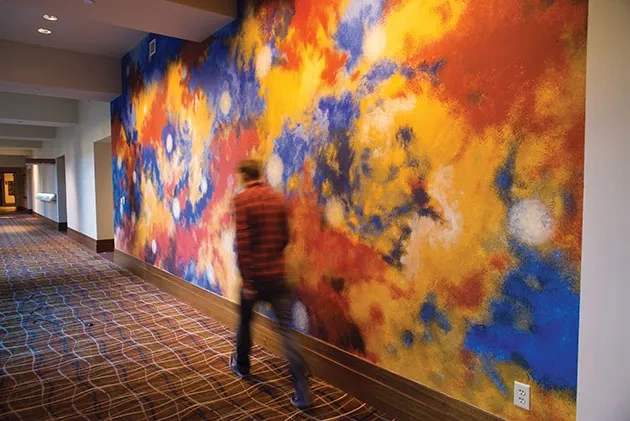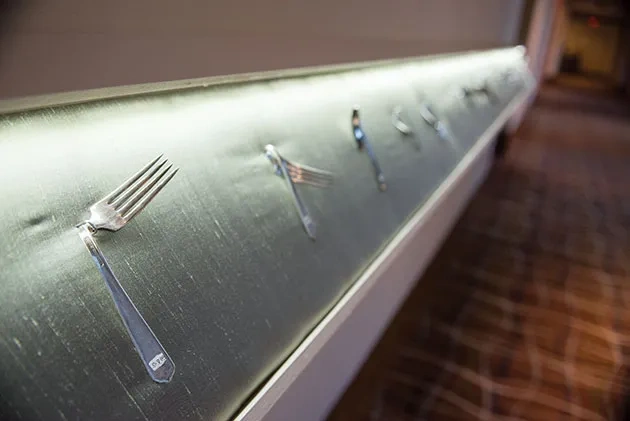Lack and Presence
The One / Sixth exhibition unites UT’s few African-American MFA in studio art alums.
On a sunny Sunday afternoon in May, a group of artists sat at a table for a discussion in front of a few dozen interested onlookers. UT art history associate professor Cherise Smith was on hand to moderate this discussion, one focused on both the cultural exclusion facing visual artists of color and the works of each artist, some of which were on display in a small gallery just a few feet away.
“It’s still a challenge that a place like UT has a paucity of students of color,” Smith mentioned in her opening remarks. In the fall of 2015, just 3.9 percent of UT students were black. “That’s low,” she laughed.
An art exhibition at a new Austin gallery called de stijl opened on May 13, featuring work from six of the seven black alumni from UT’s MFA program in studio art. Its mission is to address that paucity and to showcase the six artists’ works, which range from paintings and drawings to a sculpture made from synthetic hair. Just weeks beforehand, Christina Coleman of de stilj gallery and one of the artists featured in the exhibit confirmed that, to their knowledge, there were only six black alumni from UT’s MFA program in studio art since it began in 1961: Walter Kisner, MFA ’82; Steven Jones, MFA ’90; Zoë Charlton, MFA ’99; Robert Pruitt, MFA ’03; Coleman, MFA ’12; and Janaye Brown, MFA ’13.
But a couple of days before One / Sixth was to open on a humid Friday night, the organizers learned of a seventh black alumnus, photographer Wendel A. White, MFA ’82. The problem with finding a seventh so close to the show’s opening—beyond having already curated the show and printed specific collateral including the official show catalogue—was that the excluded artist was both a notable photographer and a classmate of Kisner’s.
So it’s seven. But six, seven, even 25 is an astonishingly low number, even considering that only nine students are accepted to the MFA program each year.
“It says something about the art world. It also says something about UT,” Smith said. “I’ll let you imagine what that says.”
Department chair Jack Risley has tried diligently to rectify the lack of diversity of students in the program in recent years, but it’s an uphill battle, especially considering that between 1961, when the program began, and 1982, when White and Kisner graduated, zero students of color earned an MFA in studio art. “We’ve been much more aggressive in leveraging our connections with other schools, soliciting colleagues for recommendations, and enhancing the reputation of our program in order to attract a more diverse pool of applicants,” Risley says. Still, it would be myopic to focus only on the cultural exclusion facing artists of color. Just as notable, in a field where few make it through the first five years post-graduation, is that all the artists included in One / Sixth are actively creating.
“This exhibition is not only to talk about lack,” Smith said. “It’s to talk about presence.”
One / Sixth runs through July 10 at de stijl in Austin.

Robert Pruitt, “Black Curves Toward Newer Galaxies”
The title of Pruitt’s 2009 charcoal piece holds multiple meanings, as a black woman shown in profile holds a “curve” painting by Ellsworth Kelly. Cultural critic Jared Richardson writes that Pruitt’s “portraits of family and friends evoke Afrofuturism, as they richly borrow material from popular science fiction, comic books, and black revolutionary cultures.”

Christina Coleman, “Diagonal Blip”
Many of Coleman’s pieces either utilize or symbolize the “highly politicized fiber” of synthetic black hair. “At one point, I asked myself about what I was really interested in,” Coleman says. “It was three things: one’s voice, skin color, and hair. These are all things that historically at one point have been used to identify someone.”

Steven Jones, “26 Degrees”
Jones’ ceramic tile sculpture, like two others in the show, are based on “alien shapes” he sketches when he’s drawing maps, something he spends a lot of his waking hours doing. “’Til the day I die, my hand will be going like this,” Jones says, mimicking doodling with an invisible pen. “I’ll be going, ‘One last thing!’”

Walter Kisner, “Created in the Image of GOD”
Kisner’s works in the show demonstrate both labored techniques—he uses a “Byzantine encaustic,” or warm beeswax with colored pigments—and focus on ancient themes. His earliest piece in the show is one he describes as the most difficult to talk about. “If you look at my work it always has something to do with God and his relationship with us and my relationship with Him,” Kisner says.

Janaye Brown, “Rocks With Salt”
Shot on New York City’s Brighton Beach, Brown’s short film is a mesmerizing, unsettling work, featuring a single shot of pulsating sand with an ambient soundtrack of waves crashing and children laughing offscreen. “Before my 30s, I started to make single-shot films: stripping everything away, very minimal emotion, to see what comes from that. I ran with that until now,” Brown says. “I’m looking for ways to expand upon that and to tell stories in this form.”

Zoë Charlton, “Cousins 1”
Part of her “Tallahasee Lassies” series, this piece is a play on the traditional family portrait, a tense display of race, class, gender, and sexuality—heavy themes underscored by her airy graphite drawings. Two and a half months before Charlton’s thesis exhibit, professor Michael Ray Charles told her to “be brave,” and scrap all her paintings and show some of her sketches instead. “That just started this other thing running,” Charlton says. “That’s why I work the way I do, stylistically.”





